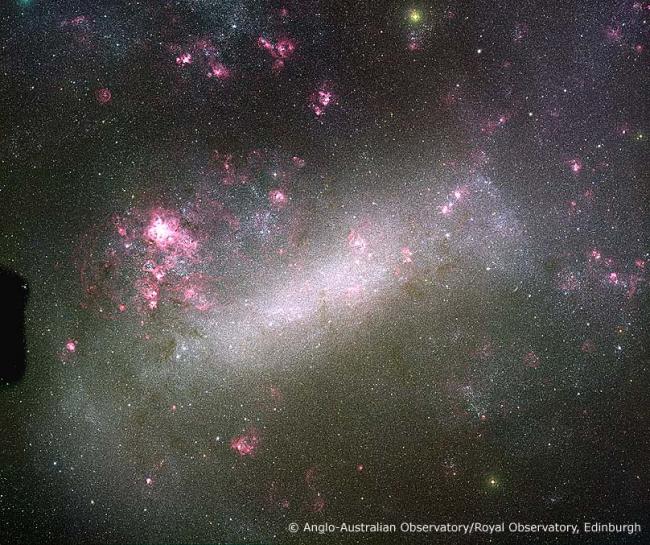
An optical image of the Large Magellanic Cloud. New research confirms that this nearby dwarf galaxy is a true satellite of the Milky Way.
Our Milky Way galaxy is not alone in its cosmic neighborhood. It belongs to the “Local Group,” a set of about 30 galaxies that are held together by their mutual gravitational attraction. The Local Group is dominated by its two most massive galaxies -- our own, and the Andromeda Galaxy, a close analog of the Milky Way that is about 2.5 million light-years away. Andromeda has eighteen smaller “satellite galaxies” clustered around it and gravitationally associated with it; the Milky Way has fourteen such satellites. The complex interactions between these galaxies help to determine how they evolve – how they rotate, for example - and the way in which the stars in spiral arms move as they orbit a galaxy's nucleus. Understanding these motions today helps astronomers determine what happened in the past to stars in the Milky Way like the sun.
The largest satellite galaxy of the Milky Way is the Large Magellanic Cloud (LMC), named for the explorer Ferdinand Magellan who saw its diffuse, cloud-like glow in the southern sky. Several years ago, astronomers studying the LMC motions calculated that it was probably not gravitationally bound to the Milky Way, that it probably formed outside of the Milky Way’s influence, and concluded that it was not a satellite galaxy. This was an important conclusion because the LMC is by far the largest of the small galaxies near us, and it was a surprising conclusion because Andromeda has several large satellites galaxies (as would be expected for such a system), and for the Milky Way to have none would be very strange. It has other implications as well. If these LMC data are correct, for example, the ancillary results imply that the solar system is about 12% closer to the galactic center than we think (12% is about double the current uncertainly in the distance of 28,000 +- 1650 light-years).
Two CfA astronomers, Genevieve Shattow and Avi Loeb, have now combined a set of newly published velocity information with their re-examination of the older data, and used them to reanalyze the combined motions of the Milky Way and its neighbors. They conclude from their computations that the earlier study was wrong – the LMC is a true satellite galaxy, the Milky Way is not unnatural member of the Local Group.
In the News
SAO astronomer Jeff McClintock has been awarded the 2009 Bruno Rossi Prize by the High Energy Astrophysics Division of the AAS, together with two of his colleagues. This prize is awarded annually in honor of Bruno Rossi "for a significant contribution to High Energy Astrophysics, with particular emphasis on recent, original work."